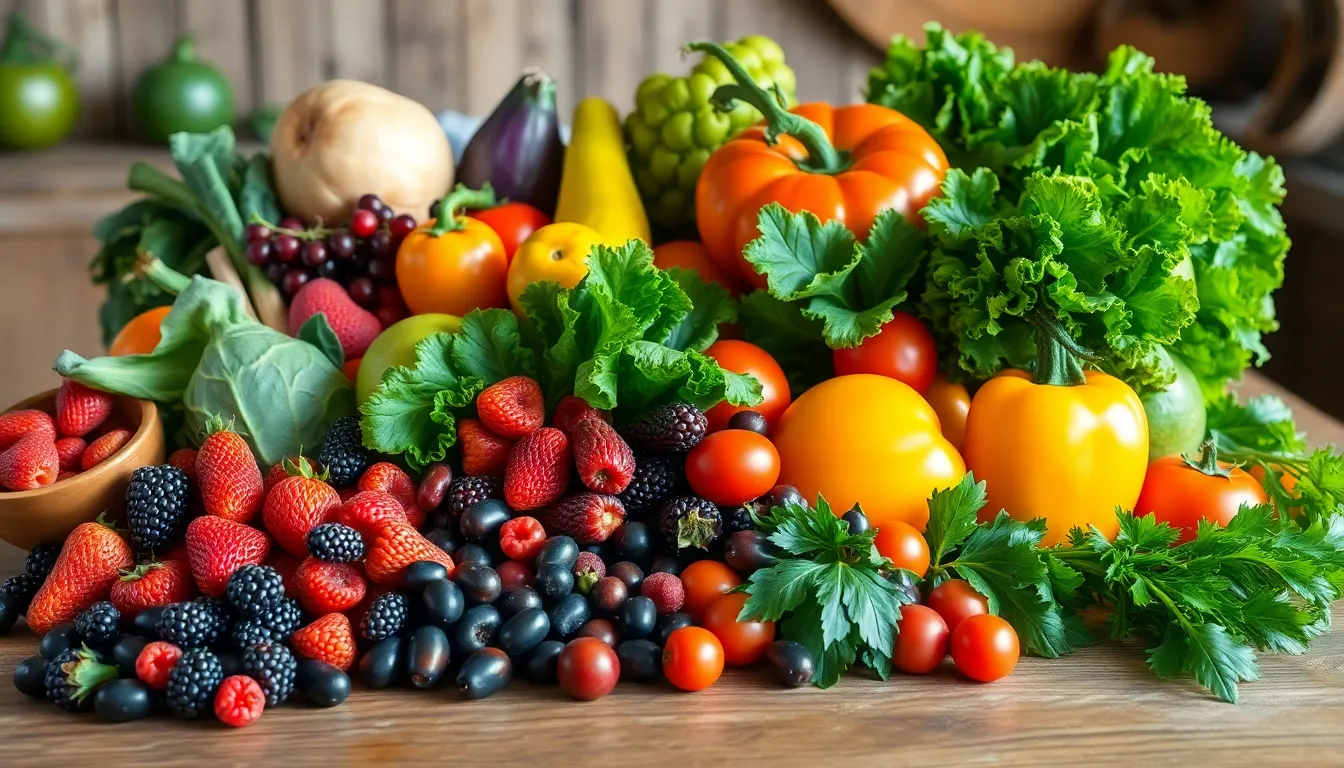Table of Contents
ToggleIn a world where kale has become a celebrity and quinoa is practically royalty, organic food options are strutting down the grocery aisle like they own the place. But what’s the real deal with these green goodies? It’s not just about being trendy; it’s about choosing food that’s as close to nature as possible, minus the chemical drama.
Understanding Organic Food Options
Organic food options refer to products grown and processed without synthetic fertilizers, pesticides, or genetically modified organisms. Consumers increasingly choose these alternatives for their perceived health benefits and environmental sustainability.
What Is Organic Food?
Organic food includes fruits, vegetables, grains, dairy, and meat produced through specific farming practices. Certification by organizations, such as the USDA, ensures that these items meet rigorous standards. Farmers emphasize using natural substances, focusing on soil health and biodiversity. Processes avoid harmful additives, enhancing the overall quality of the food.
Benefits of Organic Food
Organic food offers several health advantages. Studies suggest that organic products contain higher levels of antioxidants compared to conventionally grown counterparts. Reduced exposure to synthetic chemicals is another key benefit, promoting safer consumption. Moreover, organic farming practices support environmental sustainability, preserving ecosystems. Choosing organic products can contribute to a more sustainable food system and improve overall well-being.
Types of Organic Food Options

Various organic food options are available, catering to diverse dietary preferences and needs. Common categories include fruits, vegetables, dairy, meat, grains, and packaged goods. Each type offers unique attributes that contribute to healthy living.
Fruits and Vegetables
Organic fruits and vegetables grow without synthetic pesticides or fertilizers, promoting a healthier environment. Produce like organic berries and kale often contains a higher nutrient density compared to conventional counterparts. Farmers cultivate these crops using sustainable practices, ensuring minimal chemical exposure. Consumers frequently choose seasonal organic options for freshness and flavor. Organic certifications guarantee that fruits and vegetables adhere to strict agricultural standards, fostering trust among buyers.
Dairy and Meat Products
Organic dairy products, including milk and cheese, originate from animals raised on organic feed and pasture conditions. These animals do not receive antibiotics or growth hormones, providing a more natural source of nutrition. Consumers often prefer organic meat for its perceived health benefits and superior taste. Organic certification for meat products requires adherence to humane animal treatment practices, reflecting higher ethical standards. Selecting organic dairy and meat options contributes to a healthier diet and environment.
Grains and Packaged Goods
Organic grains contain no synthetic additives, making them a popular choice for health-conscious consumers. Examples include organic rice, oats, and quinoa, which provide essential nutrients and promote sustainable farming practices. Packaged organic goods, such as snacks and sauces, often contain fewer preservatives and artificial ingredients. Shoppers frequently opt for these items to avoid harmful chemicals in their diets. Organic certifications for grains and packaged goods ensure transparency and quality, enhancing consumer trust.
Choosing the Right Organic Food Options
Choosing organic food options involves understanding what to look for while shopping. Organic products often cost more due to specific farming methods but provide significant health benefits. He or she should prioritize items from local farms to reduce environmental impact while supporting community agriculture.
Tips for Shopping Organic
Shopping for organic items requires some strategic thinking. First, create a list of organic fruits, vegetables, and grains. By sticking to this list, shoppers can avoid impulse buys. Next, shop at farmer’s markets, where fresh organic produce is usually available. Check for seasonal items, as they tend to be cheaper and taste better. Prioritize bulk bins for purchasing grains and nuts; these options are often more affordable and eco-friendly. Shopping during sales or using store loyalty programs can also lead to savings.
Reading Organic Labels
Understanding organic labels is crucial for making informed purchases. Check for the USDA Organic seal, which guarantees adherence to strict organic standards. Products labeled as “100% organic” contain solely organic ingredients. Those marked as “organic” must consist of at least 95% organic components. Be cautious of terms like “made with organic ingredients,” which only require 70% organic contents; they may not reflect the quality consumers expect. Scrutinizing the ingredient list helps identify any non-organic additives or preservatives.
Misconceptions About Organic Food Options
Organic food options face numerous misconceptions that can mislead consumers. Understanding these myths is crucial for making informed decisions.
Common Myths
Many people believe organic food lacks nutritional value. Research often shows organic produce contains higher levels of antioxidants and essential nutrients. Another common myth is that all organic foods are pesticide-free. Organic farming uses natural pesticides, which can be safer than synthetic alternatives. Consumers also assume organic is always better for the environment. While organic practices reduce chemical usage, their impact can vary based on practices and location. Price is frequently cited as a reason to avoid organic food, but shoppers often experience long-term health benefits that offset initial costs.
Facts About Organic Farming
Organic farming adheres to strict regulations set by organizations like the USDA. These regulations require farmers to follow specific practices aimed at environmental sustainability. Crop rotation helps maintain soil health and prevents pest issues. Additionally, organic farming promotes biodiversity, as it often includes a variety of crops instead of relying on monocultures. By forgoing synthetic fertilizers, organic farming nurtures the ecosystem, benefiting surrounding wildlife. Organic practices support animal welfare by ensuring livestock are raised in humane conditions, without the use of antibiotics or growth hormones. Understanding these facts clarifies the advantages of choosing organic food options.
Choosing organic food options can significantly enhance one’s overall health and well-being. By prioritizing natural and chemical-free products, consumers not only nourish their bodies but also support sustainable farming practices. The benefits of organic foods extend beyond nutrition, promoting environmental stewardship and community agriculture.
As awareness grows around the importance of organic certifications and transparent labeling, shoppers are better equipped to make informed decisions. This conscious approach to food selection fosters a healthier lifestyle while contributing to a more sustainable food system. Embracing organic options is a step towards a better future for both individuals and the planet.





